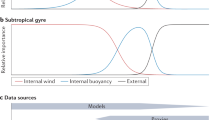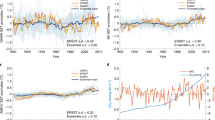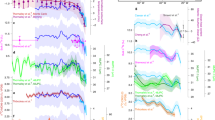Abstract
The Atlantic meridional overturning circulation (AMOC) has weakened substantially over the past decade1. Some weakening may already have occurred over the past century2, and global climate models project further weakening in response to anthropogenic climate change3. Such a weakening could have significant impacts on the surface climate4. However, ocean model simulations based on historical conditions have often found an increase in overturning up to the mid-1990s, followed by a decrease5. It is therefore not clear whether the observed weakening over the past decade is part of decadal variability or a persistent weakening6. Here we examine a state-of-the-art global-ocean reanalysis product, GloSea5, which covers the years 1989 to 2015 and closely matches observations of the AMOC at 26.5° N, capturing the interannual variability and decadal trend with unprecedented accuracy. The reanalysis data place the ten years of observations—April 2004 to February 2014—into a longer-term context and suggest that the observed decrease in the overturning circulation is consistent with a recovery following a previous increase. We find that density anomalies that propagate southwards from the Labrador Sea are the most likely cause of these variations. We conclude that decadal variability probably played a key role in the decline of the AMOC observed over the past decade.
This is a preview of subscription content, access via your institution
Access options
Subscribe to this journal
Receive 12 print issues and online access
$259.00 per year
only $21.58 per issue
Buy this article
- Purchase on Springer Link
- Instant access to full article PDF
Prices may be subject to local taxes which are calculated during checkout




Similar content being viewed by others
References
Smeed, D. A. et al. Observed decline of the Atlantic meridional overturning circulation 2004–2012. Ocean Sci. 10, 29–38 (2014).
Rahmstorf, S. et al. Exceptional twentieth-century slowdown in Atlantic ocean overturning circulation. Nature Clim. Change 5, 475–480 (2015).
Collins, M. et al. in Climate Change 2013: The Physical Science Basis (eds Stocker, T. F. et al.) Ch. 12, 1029–1136 (IPCC, Cambridge Univ. Press, 2013).
Jackson, L. C. et al. Global and European climate impacts of a slowdown of the AMOC in a high resolution GCM. Clim. Dynam. 45, 3299–3316 (2015).
Danabasoglu, G. et al. North Atlantic simulations in coordinated ocean-ice reference experiments phase II (CORE-II). Part II: inter-annual to decadal variability. Ocean Model. 97, 65–90 (2015).
Roberts, C. D., Jackson, L. & McNeall, D. Is the 2004-2012 reduction of the Atlantic meridional overturning circulation significant? Geophys. Res. Lett. 41, 3204–3210 (2014).
Smeed, D. et al. Atlantic meridional overturning circulation observed by the RAPID-MOCHA-WBTS (RAPID-Meridional Overturning Circulation and Heatflux Array-Western Boundary Time Series) array at 26N from 2004 to 2014 (British Oceanographic Data Centre-Natural Environment Research Council, UK, 2015); http://dx.doi.org/10/6qb
Roemmich, D. et al. Argo: the challenge of continuing 10 years of progress. Oceanography 22, 46–55 (2009).
Tett, S., Sherwin, T., Shravat, A. & Browne, O. How much has the North Atlantic Ocean overturning circulation changed in the last 50 years? J. Clim. 27, 6325–6342 (2014).
Karspeck, A. R. et al. Comparison of the Atlantic meridional overturning circulation between 1960 and 2007 in six ocean reanalysis products. Clim. Dynam. http://dx.doi.org/10.1007/s00382-015-2787-7 (2015).
Roberts, C. D. et al. Atmosphere drives recent interannual variability of the Atlantic meridional overturning circulation at 26.5° N. Geophys. Res. Lett. 40, 5164–5170 (2013).
Bentsen, M., Drange, H., Furevik, T. & Zhou, T. Simulated variability of the Atlantic meridional overturning circulation. Clim. Dynam. 22, 701–720 (2004).
Deshayes, J. & Frankignoul, C. Simulated variability of the circulation in the North Atlantic from 1953 to 2003. J. Clim. 21, 4919–4933 (2008).
Robson, J., Sutton, R., Lohmann, K., Smith, D. & Palmer, M. D. Causes of the rapid warming of the North Atlantic Ocean in the mid-1990s. J. Clim. 25, 4116–4134 (2012).
Yeager, S. & Danabasoglu, G. The origins of late-twentieth-century variations in the large-scale north atlantic circulation. J. Clim. 27, 3222–3247 (2014).
Roberts, C. D., Garry, F. K. & Jackson, L. C. A multimodel study of sea surface temperature and subsurface density fingerprints of the atlantic meridional overturning circulation. J. Clim. 26, 9155–9174 (2013).
Robson, J., Hodson, D., Hawkins, E. & Sutton, R. Atlantic overturning in decline? Nature Geosci. 7, 2–3 (2014).
Good, S. A., Martin, M. J. & Rayner, N. A. EN4: quality controlled ocean temperature and salinity profiles and monthly objective analyses with uncertainty estimates. J. Geophys. Res. 118, 6704–6716 (2013).
Curry, R. G., McCartney, M. S. & Joyce, T. M. Oceanic transport of subpolar climate signals to mid-depth subtropical waters. Nature 391, 575–577 (1998).
Pickart, R. S., Torres, D. J. & Clarke, R. A. Hydrography of the Labrador Sea during active convection. J. Phys. Oceanogr. 32, 428–457 (2002).
Eden, C. & Willebrand, J. Mechanism of interannual to decadal variability of the North Atlantic circulation. J. Clim. 14, 2266–2280 (2001).
Dickson, R. et al. Current estimates of freshwater flux through Arctic and subarctic seas. Progr. Oceanogr. 73, 210–230 (2007).
Riser, S. C. et al. Fifteen years of ocean observations with the global Argo array. Nature Clim. Change 6, 145–153 (2016).
Hodson, D. & Sutton, R. The impact of resolution on the adjustment and decadal variability of the Atlantic meridional overturning circulation in a coupled climate model. Clim. Dynam. 39, 3057–3073 (2012).
Blanke, B., Speich, S., Madec, G. & Döös, K. A global diagnostic of interocean mass transfers. J. Phys. Oceanogr. 31, 1623–1632 (2001).
Bower, A. S. et al. Interior pathways of the North Atlantic meridional overturning circulation. Nature 459, 243–247 (2009).
Molinari, R. L. et al. The arrival of recently formed Labrador Sea water in the deep western boundary current at 26.5° N. Geophys. Res. Lett. 25, 2249–2252 (1998).
MacLachlan, C. et al. Global seasonal forecast system version 5 (GloSea5): a high resolution seasonal forecast system. Q. J. R. Meteorol. Soc. 141, 1072–1084 (2014).
Blockley, E. W. et al. Recent development of the Met Office operational ocean forecasting system: an overview and assessment of the new global FOAM forecasts. Geosci. Model Dev. 7, 2613–2638 (2014).
Megann, A. et al. GO5.0: the joint NERC–Met Office NEMO global ocean model for use in coupled and forced applications. Geosci. Model Dev. 7, 1069–1092 (2014).
Mirouze, I., Blockley, E., Lea, D., Martin, M. & Bell, M. A multiple length scale correlation operator with application to ocean data assimilation. Tellus A 68, 29744 (2016).
Dee, D. P. et al. The ERA-Interim reanalysis: configuration and performance of the data assimilation system. Q. J. R. Meteorol. Soc. 137, 553–597 (2011).
Altimeter products were produced by Ssalto/Duacs and distributed by AVISO, with support from CNES. (2015); http://www.aviso.altimetry.fr/duacs
Casey, K., Brandon, T., Cornillon, P. & Evans, R. in Oceanography from Space: Revisited (eds Barale, V., Gower, J. & Alberotanza, L.) Ch. 16, 273–287 (Springer, 2010).
Data from the (A)ATSR instruments are provided courtesy of the Natural Environment Research Council, STFC Rutherford Appleton Laboratory, the European Space Agency and Defra, through the NERC Earth Observation Data Centre (NEODC). (NERC, 2015); http://neodc.nerc.ac.uk
EUMETSAT Ocean and Sea Ice Satelitte Application Facility. Global sea ice concentration reprocessing dataset 1978–2009 (v1.1, 2011) (EUMETSAT, 2011); http://osisaf.met.no
GHRSST: The Group for High Resolution Sea Surface Temperature (2015); https://www.ghrsst.org
Acknowledgements
This work was supported by the Joint UK DECC/Defra Met Office Hadley Centre Climate Programme (GA01101), the Public Weather Service Research programme, and the EU SPECS project (GA308378). The authors also wish to thank the Met Office Ocean Forecasting, Research and Development team for providing the FOAMv13 system, and B. Blanke and N. Grima for developing and supporting the use of Ariane.
Author information
Authors and Affiliations
Contributions
L.C.J. led the writing of the paper, K.A.P. developed and performed the GloSea5 reanalysis, and L.C.J. and C.D.R. performed the analysis. All authors, including R.A.W., contributed to writing and editing the paper.
Corresponding author
Ethics declarations
Competing interests
The authors declare no competing financial interests.
Supplementary information
Supplementary Information
Supplementary Information (PDF 875 kb)
Rights and permissions
About this article
Cite this article
Jackson, L., Peterson, K., Roberts, C. et al. Recent slowing of Atlantic overturning circulation as a recovery from earlier strengthening. Nature Geosci 9, 518–522 (2016). https://doi.org/10.1038/ngeo2715
Received:
Accepted:
Published:
Issue Date:
DOI: https://doi.org/10.1038/ngeo2715
This article is cited by
-
Decadal changes in Atlantic overturning due to the excessive 1990s Labrador Sea convection
Nature Communications (2023)
-
Likely accelerated weakening of Atlantic overturning circulation emerges in optimal salinity fingerprint
Nature Communications (2023)
-
Atlantic meridional overturning circulation increases flood risk along the United States southeast coast
Nature Communications (2023)
-
Projected Atlantic overturning slow-down is to be compensated by a strengthened South Atlantic subtropical gyre
Communications Earth & Environment (2023)
-
North Atlantic Oscillation contributes to the subpolar North Atlantic cooling in the past century
Climate Dynamics (2023)



